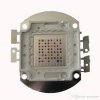cheers
@arty zan, i was just curious.. kinda wanted to know where he was talking about.. haha
i think this diy cob might be a good idea especially if its cheap! thanks for the recommendation.
Basically the guy,was living somewhere where they didn't sell Compact Fluorescent Lights (CFL's) aka energy saving bulbs.
He couldn't get red or blue CFL's where he lived.
The colour of the light is express as a number value in the Kelvin scale.
CFL's use the Kelvin scale to let us know how warm or how cool the light is that is being given out.
Basic rule of thumb is, if a lights colour is on the blue side of the spectrum it is used for veg period and if it is on the red side of the spectrum it is used for flowering.
A mixture of warm and cool bulbs evens out the spectrum and can be adjusted to suit a persons growing needs - more blue veg, more red bloom.
LED's are different, in that they can acurately target certain nanometer(nm) ranges of the light spectrum.
A mixture of these targeted LED's are used to make a full spectrum array, expressing certain colours to a greater or lesser degree than others. For instance having more red than blue on in the lighting unit.
The range of light used by plants in photosynthesis is between 350nm to 800nm.
A LED unit/light, containing an assortment of targeted coloured LED's in the 350nm - 800nm range at the correct ratio, can provide the plants lighting needs.
Many LED lights uses 3W & 5W single LED's to make up a full led light.
Other LED lights use Chips Called cobs.
Cob stands for Chip On board but when they first came on the market they we refered to as Intergrated LED Arrays but that was a bit of a mouth full.
Some cob chips are made up of an matrix array of tiny spectrum targeted (nm) leds in a variety of colours, which can include blue, red, deep red, far red & IR= infrared and also sometimes green.
Cob's may also incorporate warm white and cool white chips, to even out the spectrum, in addition to the spectrum specific(nm) targeted LED chips .
This (above) is a full spectrum targeted cob which been specifically designed for horticulture. This type of cob will give the you that pinky LED glow.
This is a 3500K warm white cob which has more red and yellow light emitted but also emits other parts of the spectrum but to less of an extent.
There are also Cobs which give out a white light (as above).
The white colour is express as kelvin measurement.
A 3500K cob is refered to as warm white and a 7000K cob is refered to as cool white.
Other types of light also have different spectral qualities in different parts of the spectrum.
HPS give out a red/pinky orange light and MH is more blueish in colour, the light emitted by them also covers other parts of the spectrum.
These are typical measurements for the main types of HID's used by growers Metal Halide is more blue (cool light) and the High Pressure Sodium is more Red/Pinky Orange (warm light)
The white line shows the part of the spectrum and the intensity of that light in each given part of the spectrum used by the plant in photosynthesis.
p
hotosynthetically active radiation, often abbreviated
PAR, designates the spectral range (wave band) of solar radiation from 400 to 700 nanometers that photosynthetic organisms are able to use in the process of photosynthesis.
So back to the story.
The guy wanted know what to use in veg mode and flower mode but seeing as he wasn't able to pop down the shops and grab what he needed, he wanted to know what alternative light sources he could use.
Problem with using CFL's is the can be broken and also lose efficiency fairly quickly in comparison to LED and so would need to be be replaced fairly frequently & with no shop on his islands selling CFL's this wasn't an option.
My advice to him was to Buy buy an LED/LED kit, the LED unit will operate for many thousands of hours before it is time for a new one and a DIY/KIT is a cost effective option.
An LED light/kit can be easily shipped to most places in the world of course there are always exceptions.
I should also add I have been an LED nut for many years and have watched the progression from useless crap to amazing and as I still keep watching, my mouth is forever dropping a little more as each year goes by.I may be a little biased lol.
I should also point out I've grown with CFL's too and had a great time and I have also grown with hps, with great results but I just love my LED's.
Apologies if I have gone over stuff you already know but i wanted to be clear and cover all bases rather than assume anything.
You never know someone may not know some of the above and find it useful.
I hope I haven't been overly verbose.
Cheers Arty





